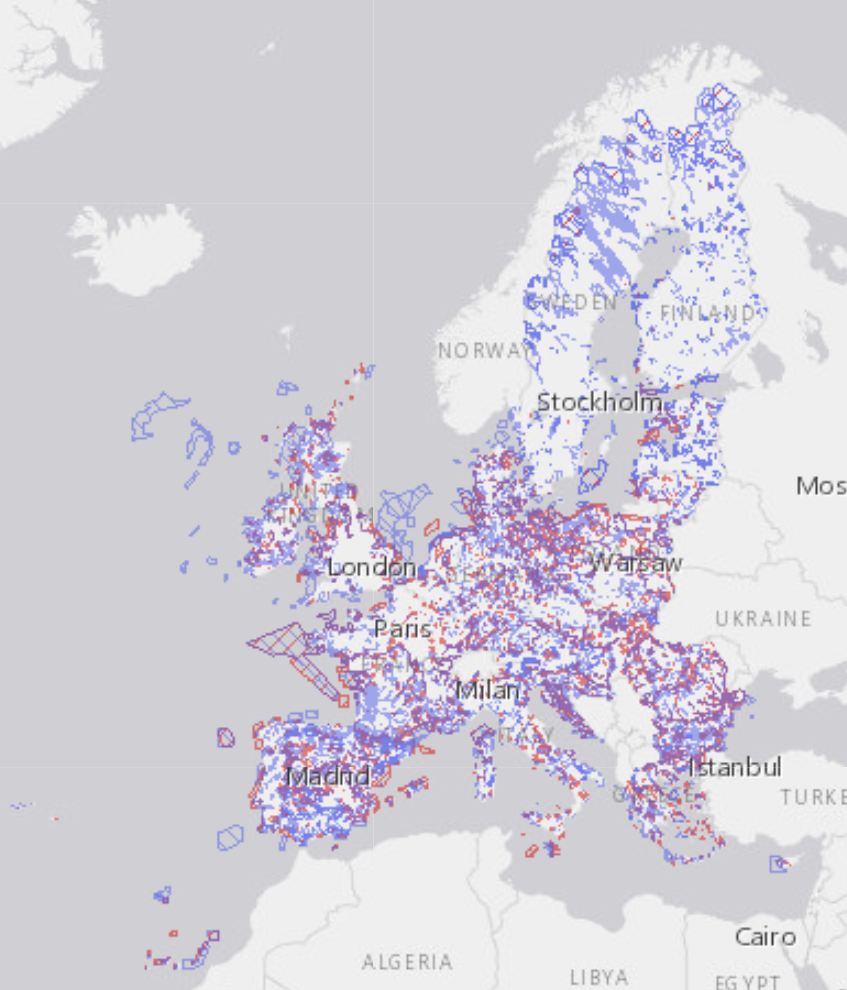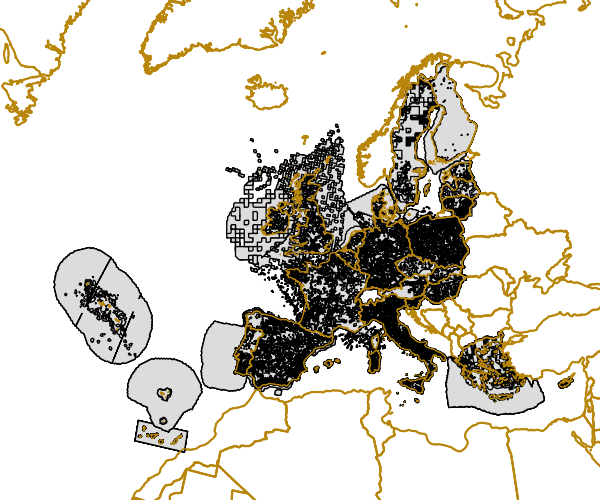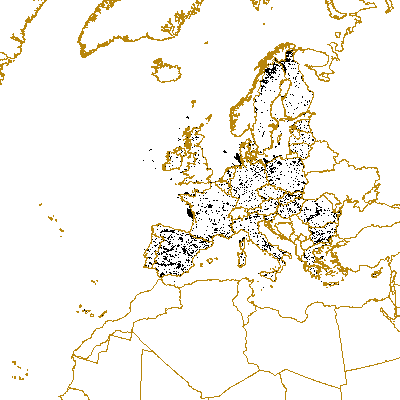European Commission
Type of resources
Available actions
Topics
INSPIRE themes
Keywords
Contact for the resource
Provided by
Years
Formats
Representation types
Update frequencies
status
Scale
Resolution
-

Natura 2000 is the key instrument to protect biodiversity in the European Union. It is an ecological network of protected areas, set up to ensure the survival of Europe's most valuable species and habitats. Natura 2000 is based on the 1979 Birds Directive and the 1992 Habitats Directive. This version covers the reporting in 2019. Natura 2000 is an ecological network composed of sites designated under the Birds Directive (Special Protection Areas or SPAs) and the Habitats Directive (Sites of Community Importance or SCIs, and Special Areas of Conservation or SACs). The European database of Natura 2000 sites consists of a compilation of the data submitted by the Member States of the European Union. This European database is generally updated once a year to take into account any updating of national databases by Member States. However, the release of a new EU-wide database does not necessarily mean that a particular national dataset has recently been updated. The descriptive data in the European database are based on the information that national authorities have submitted, for each of the Natura 2000 sites, through a site-specific standard data form (SDF). In addition to other site-specific information, the standard data form provides the list of all species and habitat types for which a site is officially designated. The spatial data (outlining the boundaries of sites) submitted by each Member State are validated by the European Environment Agency (EEA). Any problems identified through the above validation procedures in the national datasets are brought to the attention of the Member States concerned. However, it remains up to the Member States to decide whether to submit a revised dataset before the European database is updated. The EEA therefore cannot guarantee that all inconsistences detected in national datasets are removed in the European dataset. Please note that some Member States have submitted sensitive information that has been filtered out of this database. The following Member States have submitted sensitive information: Austria, Belgium, Cyprus, Estonia, Finland, France, Germany, Ireland, Italy, Latvia, Lithuania, Luxembourg, Malta, Poland, Portugal, Slovakia, Spain, Sweden and United Kingdom. This concerns mainly species associated to specific sites. All reference to these species has been removed from the related sites. If this sensitive information is necessary to your field of research, please contact the Member State administrations individually. You can find a compiled list of national or regional Natura 2000 websites at the following address: http://ec.europa.eu/environment/nature/natura2000/db_gis/index_en.htm#sites There are specific terms and conditions relating to the use of downloaded boundary data within the United Kingdom. If you intend to use the UK data, you must first agree to the end-user licence http://www.jncc.gov.uk/page-5232. Besides the web service link provided in the metadata, the following services provide information on species and habitat types inside the Natura 2000 sites: https://bio.discomap.eea.europa.eu/arcgis/rest/services/ProtectedSites/Natura2000Habitats/MapServer https://bio.discomap.eea.europa.eu/arcgis/rest/services/ProtectedSites/Natura2000Species/MapServer NOTE: The dataset has been corrected in June 2020 and the files uploaded on the SDI on 30 July 2020. Files downloaded before that date has one invalid site type code (G) that was corrected (to B) in June.
-

Gridded Distribution of Species as reported during the Article 17 of the Habitats Directive (92/43/EEC) covering the period 2001 to 2006. The data covers the EU 25. All Member States are requested by the Habitats Directive (92/43/EEC) to monitor habitat types and species considered to be of Community interest. Article 17 of the Habitats Directive 92/43/EEC requires that every 6 years Member States prepare reports to be sent to the European Commission on the implementation of the Directive. The Article 17 report for the period 2001-2006 for the first time includes assessments on the conservation status of the habitat types and species of Community interest. Information on the data quality of the 2001-2006 reporting round is available at http://bd.eionet.europa.eu/article17.
-

Natura 2000 is an ecological network composed of sites designated under the Birds Directive (Special Protection Areas, SPAs) and the Habitats Directive (Sites of Community Importance, SCIs, and Special Areas of Conservation, SACs). The European database on Natura 2000 sites consists of a compilation of the data submitted by Member States to the European Commission. This European database is generally updated once per year, so as to take into account any updating of the content of the national databases by Member States. However, the release of a new EU-wide database does not necessarily entail that a particular national dataset has recently been updated. The descriptive data in the European database are based on the information that national authorities have submitted, for each of the Natura 2000 sites, through a site-specific standard data form (SDF). Amongst other site-specific information, the standard data form provides the list of all species and habitat types for which a site is officially designated. The spatial data (borders of sites) submitted by each Member State are validated by the European Environment Agency (EEA), including as regard their consistency with the descriptive data. Any problems identified through the above validation procedures in the national datasets are brought to the attention of the Member States concerned. However, it remains up to the Member States to decide whether or not to submit a revised dataset before the European database is updated. As a consequence, the EEA cannot guarantee that all inconsistences detected in national datasets are removed in the European dataset. Please note that some Member States have submitted sensitive information that has been filtered out of this database. The following Member States have submitted sensitive information: Austria, Finland, France, Germany, Ireland, Italy, Latvia, Luxembourg, Poland, Spain and Sweden. This concerns mainly species associated to specific sites. All reference to these species has been removed from the related sites. If this sensitive information is necessary to your field of research, please contact the Member States' administrations individually. You can find a compiled list of national or regional Natura 2000 websites at the following address: http://ec.europa.eu/environment/nature/natura2000/db_gis/index_en.htm#sites There are specific terms and conditions relating to the use of downloaded boundary data within the United Kingdom. If you intend to use the UK data you must first agree to the end user licence http://www.jncc.gov.uk/page-5232.
-

Natura 2000 is the key instrument to protect biodiversity in the European Union. It is an ecological network of protected areas, set up to ensure the survival of Europe's most valuable species and habitats. Natura 2000 is based on the 1979 Birds Directive and the 1992 Habitats Directive. Natura 2000 is an ecological network composed of sites designated under the Birds Directive (Special Protection Areas, SPAs) and the Habitats Directive (Sites of Community Importance, SCIs, and Special Areas of Conservation, SACs). For each Natura 2000 site, national authorities have submitted a standard data form (SDF) that contains an extensive description of the site and its ecology. The European Topic Centre for Biological Diversity (ETC/BD), based in Paris, is responsible for validating these datasets and for creating an EU wide descriptive database . The European database on Natura 2000 sites consists of data submitted by Member States to the European Commission. The European database is generally updated once per year, so as to take into account any updating of the content of the national databases by Member States. After validation a new EU-wide Natura 2000 database is released. However, the release of a new EU-wide database does not provide any guarantee that a particular national dataset has recently been updated. The spatial data (borders of sites) submitted by each Member State is validated by the European Environment Agency (EEA) and linked to the descriptive data. Any problems identified during this process are brought to the attention of the concerned Member States. There are specific terms and conditions relating to the use of downloaded boundary data within the United Kingdom. If you intend to use the UK data you must first agree to the end user licence http://www.jncc.gov.uk/page-5232. Please note that some Member States have submitted sensitive information that has been filtered out of this database. The following Member States have submitted sensitive information: Austria, Finland, France, Germany, Ireland, Italy, Latvia, Luxembourg, Poland, Spain and Sweden. This concerns mainly species associated to specific sites. All reference to these species has been removed from the related sites. If this sensitive information is necessary to your field of research, please contact the Member States' administrations individually. You can find a compiled list of national or regional Natura 2000 websites at the following address: http://ec.europa.eu/environment/nature/natura2000/db_gis/index_en.htm#sites
-

Natura 2000 is the key instrument to protect biodiversity in the European Union. It is an ecological network of protected areas, set up to ensure the survival of Europe's most valuable species and habitats. Natura 2000 is based on the 1979 Bird's Directive and the 1992 Habitat's Directive. The green infrastructure it provides safeguards numerous ecosystem services and ensures that Europe's natural systems remain healthy and resilient. Natura 2000 is an ecological network composed of sites designated under the Birds Directive (Special Protection Areas, SPAs) and the Habitats Directive (Sites of Community Importance, SCIs, and Special Areas of Conservation, SACs). For each Natura 2000 site, national authorities have submitted a standard data form (SDF) that contains an extensive description of the site and its ecology. The European Topic Centre for Biological Diversity (ETC/BD), based in Paris, is responsible for validating this data and creating an EU wide descriptive database. The European database on Natura 2000 sites consists of data submitted by Member States to the European Commission. This data is subject to a regular validation and updating process. After validation a new EU-wide Natura 2000 database is released. The date of release of a new EU-wide database does not guarantee that the data has been regularly and uniformly updated by Member States. The spatial data (borders of sites) submitted by each Member State is validated by the European Environment Agency (EEA) and linked to the descriptive data. Any problems identified during this process are brought to the attention of the concerned Member States. There are specific terms and conditions relating to the use of downloaded boundary data within the United Kingdom. If you intend to use the UK data you must first agree to the end user licence http://www.jncc.gov.uk/page-5232. Please note that some Member States have submitted sensitive information that has been filtered out of this database. The following Member States have submitted sensitive information: Austria, Bulgaria, Cyprus, Finland, Germany, Ireland, Latvia, Luxembourg, Sweden and United Kingdom. This concerns mainly species associated to specific sites. All reference to these species has been removed from the related sites. If this sensitive information is necessary to your field of research, please contact the Member States' administrations individually. You can find a compiled list of national or regional Natura 2000 websites at the following address: http://ec.europa.eu/environment/nature/natura2000/db_gis/index_en.htm#sites
-

This dataset was built from the original Natura 2000 vector. The raster grid is aligned with the EEA reference grid GeoTIFFs generated by GRASS, according to the GeoTIFF Revision 1.0 specifications at http://www.remotesensing.org/geotiff/spec/geotiffhome.html. The information displays if there is or not Natura 2000 sites under each specific pixel zone.
-

Natura 2000 is the key instrument to protect biodiversity in the European Union. It is an ecological network of protected areas, set up to ensure the survival of Europe's most valuable species and habitats. Natura 2000 is based on the 1979 Bird's Directive and the 1992 Habitat's Directive. The green infrastructure it provides safeguards numerous ecosystem services and ensures that Europe's natural systems remain healthy and resilient. Natura 2000 is an ecological network composed of sites designated under the Birds Directive (Special Protection Areas, SPAs) and the Habitats Directive (Sites of Community Importance, SCIs, and Special Areas of Conservation, SACs). For each Natura 2000 site, national authorities have submitted a standard data form (SDF) that contains an extensive description of the site and its ecology. The European Topic Centre for Biological Diversity (ETC/BD), based in Paris, is responsible for validating this data and creating an EU wide descriptive database. The European database on Natura 2000 sites consists of data submitted by Member States to the European Commission. This data is subject to a regular validation and updating process. After validation a new EU-wide Natura 2000 database is released. The date of release of a new EU-wide database does not guarantee that the data has been regularly and uniformly updated by Member States. The spatial data (borders of sites) submitted by each Member State is validated by the European Environment Agency (EEA) and linked to the descriptive data. Any problems identified during this process are brought to the attention of the concerned Member States. There are specific terms and conditions relating to the use of downloaded boundary data within the United Kingdom. If you intend to use the UK data you must first agree to the end user licence http://www.jncc.gov.uk/page-5232. Please note that some Member States have submitted sensitive information that has been filtered out of this database. The following Member States have submitted sensitive information: Austria, Bulgaria, Cyprus, Czech Republic, Finland, Germany, Ireland, Latvia, Luxembourg, Malta, Romania, Slovakia, Sweden and United Kingdom. This concerns mainly species associated to specific sites. All reference to these species has been removed from the related sites. Certain descriptive fields, possibly mentioning the presence of these species, have also been removed. If this sensitive information is necessary to your field of research, please contact the Member States' administrations individually. You can find a compiled list of national or regional Natura 2000 websites at the following address: http://ec.europa.eu/environment/nature/natura2000/db_gis/index_en.htm#sites
-

This dataset was built from the original Natura 2000 vector. The raster grid is aligned with the EEA reference grid GeoTIFFs generated by GRASS, according to the GeoTIFF Revision 1.0 specifications at http://www.remotesensing.org/geotiff/spec/geotiffhome.html. The information displays if there is or not Natura 2000 sites under each specific pixel zone.
-

This dataset was built from the original Natura 2000 vector. The raster grid is aligned with the EEA reference grid GeoTIFFs generated by GRASS, according to the GeoTIFF Revision 1.0 specifications at http://www.remotesensing.org/geotiff/spec/geotiffhome.html. The information displays if there is or not Natura 2000 sites under each specific pixel zone.
-

Natura 2000 is an ecological network composed of sites designated under the Birds Directive (Special Protection Areas, SPAs) and the Habitats Directive (Sites of Community Importance, SCIs, and Special Areas of Conservation, SACs). The European database on Natura 2000 sites consists of a compilation of the data submitted by Member States to the European Commission. This European database is generally updated once per year, so as to take into account any updating of the content of the national databases by Member States. However, the release of a new EU-wide database does not necessarily entail that a particular national dataset has recently been updated. The descriptive data in the European database are based on the information that national authorities have submitted, for each of the Natura 2000 sites, through a site-specific standard data form (SDF). Amongst other site-specific information, the standard data form provides the list of all species and habitat types for which a site is officially designated. The spatial data (borders of sites) submitted by each Member State are validated by the European Environment Agency (EEA), including as regard their consistency with the descriptive data. Any problems identified through the above validation procedures in the national datasets are brought to the attention of the Member States concerned. However, it remains up to the Member States to decide whether or not to submit a revised dataset before the European database is updated. As a consequence, the EEA cannot guarantee that all inconsistences detected in national datasets are removed in the European dataset. Please note that some Member States have submitted sensitive information that has been filtered out of this database. The following Member States have submitted sensitive information: Austria, Finland, France, Germany, Ireland, Italy, Latvia, Luxembourg, Poland, Spain and Sweden. This concerns mainly species associated to specific sites. All reference to these species has been removed from the related sites. If this sensitive information is necessary to your field of research, please contact the Member States' administrations individually. You can find a compiled list of national or regional Natura 2000 websites at the following address: http://ec.europa.eu/environment/nature/natura2000/db_gis/index_en.htm#sites There are specific terms and conditions relating to the use of downloaded boundary data within the United Kingdom. If you intend to use the UK data you must first agree to the end user licence http://www.jncc.gov.uk/page-5232.
 RUC Geo-Data catalogue
RUC Geo-Data catalogue